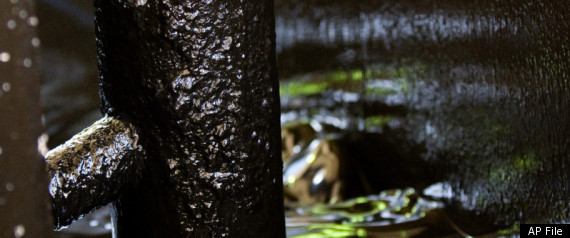


-- Pennsylvania's top environmental regulator says he is confident that the natural gas industry is just weeks away from ending one of its more troubling environmental practices: the discharge of vast amounts of polluted brine into rivers used for drinking water.
On Tuesday, the state's new Republican administration called on drillers to stop using riverside treatment plants to get rid of the millions of barrels of ultra-salty, chemically tainted wastewater that gush annually from gas wells.
As drillers have swarmed Pennsylvania's rich Marcellus Shale gas fields, the industry's use and handling of water has been a subject of intense scrutiny.
The state's request was made after some researchers presented evidence that the discharges were altering river chemistry in a way that had the potential to affect drinking water.
For years, the gas industry has bristled and resisted when its environmental practices have been criticized.
But last week, it abruptly took a different tone.
Even before the initiative to end river discharges was announced publicly, it had received the support of drillers. By Wednesday evening, a leading industry group, the Marcellus Shale Coalition, had announced that its members were committed to halting the practice by the state's stated goal of May 19.
"Basically, I see this as a huge success story," said Michael Krancer, acting secretary of the Department of Environmental Protection. "This will be a vestige of the past very quickly."
After May 19, almost all drillers will either be sending the waste to deep disposal wells – mostly in Ohio – or recycling it in new well projects, he said.
While the movement to end the wastewater discharges followed years of environmentalists' criticism, the most influential push may have come from within the industry itself.
Among major gas-producing states, Pennsylvania is the only one that allowed the bulk of its well brine to be treated and dumped in rivers and streams. Other states required it to be injected into deep underground shafts.
Publicly, the industry – and the state – argued that the river discharges were harmless to humans and wildlife.
Just months ago, the industry was actively opposing new state regulations intended to protect streams from the brine, saying fears about the river discharges were overblown.
But simultaneously, some companies were concerned.
John Hanger, Krancer's predecessor as Pennsylvania's environmental secretary, said that as early as 2008 he had been approached by two of the state's most active drillers – Range Resources, of Fort Worth, Texas, and Atlas Energy, now a subsidiary of Chevron, warning that the state's permissive rules had left rivers and streams at risk from the salty dissolved solids, particularly bromides, present in produced well water.
"They came to me and said, if this rule doesn't change, there could be enormous amounts of wastewater high in (total dissolved solids) pouring into the rivers," Hanger said.
Almost since then, the companies have been working on alternative disposal methods.
"We never thought that it was a good practice to begin with," said Range Resources spokesman Matt Pitzarella.
For months, drillers have been introducing technology that returns brine to deep wells, rather than discarding it as waste. By the end of last year, this reuse was being considered by most big drillers as the industry's future.
Efforts to curtail the waste flow accelerated, though, after a series of critical media reports, increased pressure from the Environmental Protection Agency, and new research that raised questions about whether drinking water was being compromised.
After reviewing that research, Range Resources began lobbying other drillers to confront the problem once and for all, and to do it publicly, Pitzarella said.
"I don't think that it's a stretch to say that the traditional way this industry has operated isn't going to work in the long run," he said. "We aren't going to fly beneath the radar, nor should we. And when we don't talk about these issues, someone else does."
The water that flows from active wells is often contaminated with traces of chemicals injected into the wells during a drilling procedure called hydraulic fracturing, or fracking, which breaks up the shale and frees natural gas. The flowback water also brings back from underground such naturally existing contaminants as barium, strontium, and radium.
Worries about the contaminants took on added urgency after the Monongahela River, a western Pennsylvania waterway that serves as a major source of drinking water for Pittsburgh and communities to its south, became so salty in 2008 that people began complaining about the taste.
The Department of Environmental Protection responded by curtailing the amount of wastewater sent to plants on the Monongahela. It also wrote new rules barring wastewater treatment plants from accepting more drilling wastewater than already permitted unless they were capable of turning out effluent with salt levels that met drinking water standards.
Those rules, though, left most of the existing wastewater treatment plants alone, and between 15 and 27 continued to pump out millions of gallons of water that scientists said was still high in some pollutants.
Over the past year and a half, a handful of researchers, including Jeanne VanBriesen, a professor of civil engineering at Carnegie Mellon University, and Stanley States, director of water quality at the Pittsburgh Water and Sewer Authority, have been collecting evidence on an increase in bromide in rivers that were being used for gas wastewater disposal.
By itself, bromide is harmless, but when combined with the chlorine used to sanitize drinking water supplies, it can produce substances called trihalomethanes that have been linked in some studies to increased human cancer rates after years of exposure or consumption.
The industry has, until now, expressed mostly skepticism about any possible link between drilling waste and water quality problems.
When The Associated Press reported in January that some drinking water systems close to gas wastewater treatment plants had struggled to meet EPA standards for trihalomethanes, the article was written off by industry groups as irresponsible, as was a similar report by The New York Times in February that focused on the presence of radium in drilling waste.
But in recent weeks, Range Resources arranged for VanBriesen and States to present some of their preliminary findings on bromide to a gathering of industry representatives.
VanBriesen said she cautioned that her own findings didn't necessarily point the finger decisively at natural gas waste as the main culprit behind rising bromide levels.
Only one of the waterways where she documented high bromide levels, the South Fork Tenmile Creek, even has a gas wastewater plant. It is equally possible, she said, that the majority of the pollution is being caused by wastewater discharges from coal-fired power plants.
"There are lots of power plants, and only a few brine treatment facilities," she noted.
Still, her presentations had an impact, she said.
"I think what you are seeing is a realization that the problem isn't going away," VanBriesen said. "I'm not pushing the panic button ... but it's a directional change that you don't want to continue."
Marcellus Shale Coalition President Kathryn Klaber said that after reviewing those findings, her group now believes the industry is partly responsible for the rising bromide levels.
In her letter to Krancer on Wednesday, she promised that the industry was taking action, but also encouraged state officials to evaluate whether other "sources" were contributing to the problem.
Krancer promised that evaluation would indeed happen, but he said he believed the gas industry's actions would lead to immediate improvements in river bromide levels.
"The proof will be in the pudding," he said.
He added that advances in recycling technology had positioned the industry to wean itself from treatment plants that do river discharges.
Recycling wastewater also makes business sense. It saves companies the expense of purchasing vast amounts of clean water to use in hydraulic fracturing, a process that involves injecting fluid deep underground at high pressure to shatter shale beds and free trapped gas.
It also brings substantial public relations benefits.
Gas companies can only drill if they can persuade landowners to lease their rights to the shale, buried deep beneath their properties. And people who think the drilling is going to contaminate their water supply are reluctant to lease.
"More than being a public health issue, it is a public trust issue," Pitzarella said.
Whether the action will lessen overall criticism of the industry, and the practice of hydraulic fracturing, is unknown.
Environmentalists continue to have concerns that methane gas loosed by the process can migrate into aquifers underground and get into people's water wells and homes. There have also been instances in which the high volumes of chemically tainted water injected into the ground during the fracturing process have escaped into the environment.
Last week, an equipment failure in a wellhead connection caused a blowout at a Chesapeake Energy Corp. well in Bradford County, resulting in a spill of several thousands of gallons of tainted water into a farm fields and streams.
Krancer said he didn't believe the industry, overall, was environmentally hazardous.
"I continue to believe that fracking is safe," he said.
___
Associated Press writer Marc Levy contributed to this report.

























